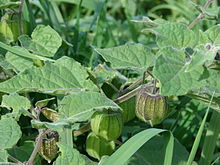Physalis
|
Physalis Temporal range: Early Eocene to Recent, 52–0 Ma |
|
|---|---|
 |
|
| cape gooseberry (Physalis peruviana) leaves and fruit | |
| Scientific classification | |
| Kingdom: | Plantae |
| (unranked): | Angiosperms |
| (unranked): | Eudicots |
| (unranked): | Asterids |
| Order: | Solanales |
| Family: | Solanaceae |
| Subfamily: | Solanoideae |
| Tribe: | Physaleae |
| Subtribe: | Physalinae |
| Genus: |
Physalis L. |
| Species | |
|
About 75-90, see text |
|
| Synonyms | |
|
Alkekengi Mill. |
|
About 75-90, see text
Alkekengi Mill.
Herschellia Bowdich ex Rchb.
Pentaphitrum Rchb.
Physalis (/ˈfaɪsəlɪs/, sometimes /faɪˈseɪlɪs/, from physalis = bladder) is a genus of flowering plants in the nightshade family (Solanaceae), which grow in warm temperate and subtropical regions of the world. Most of the species, of which there may be 75-90, are indigenous to the New World. Cultivated species and weedy annuals have been introduced worldwide. A notable feature is the formation of a large papery husk derived from the calyx, which partly or fully encloses the fruit. The fruit is small and orange, similar in size, shape and structure to a small tomato.
At least 46 species are endemic to the country of Mexico.
Many Physalis species are called groundcherries. One name for Physalis peruviana is Inca berry; another is Cape gooseberry, not to be confused with the true gooseberries, which are of the genus Ribes in the family Grossulariaceae. Other names used to refer to the fruit are poha berries, and simply golden berries.
...
Wikipedia
